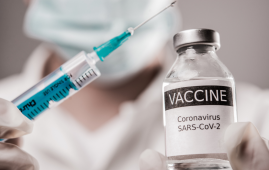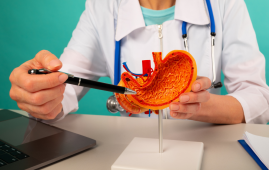

A team of UC Davis researchers lead by bioengineer Aijun Wang devised and tested a scaffold, which can help large severe burn wounds recover faster. The intriguing new treatment was discovered to enhance the creation of new blood vessels and decrease problems associated with open burn wounds. It may also lessen the need for skin grafting in patients with extensive burns throughout their bodies.
Scaffolds are constructed of an artificial biomaterial that supports the development of new tissue. Normal skin tissue consists of skin cells and an extracellular matrix that contains proteins and tiny chemicals that aid in tissue repair and nourishment. At large deep burn wound locations, these cells and extracellular matrix constituents are destroyed.
Wang and his colleagues created a scaffold that has been modified with a particular molecule called LXW7, which specifically interacts with endothelial cells to aid in wound healing.
“Endothelial cells are essential for the body’s homeostasis and regeneration.” “They aid in the formation of blood vessels during wound healing and regulate the movement of substances throughout the body,” said Wang, a professor of surgery and biomedical engineering. He also serves as vice chair for translational research, innovation, and entrepreneurship in the Department of Surgery, co-oversees the Center for Surgical Bioengineering, and directs the Wang Lab at UC Davis.
“At UC Davis, we created the LXW7 molecule, which interacts with endothelial cells and aids in their attachment, migration, and survival.” Commonly used scaffolds lack particular endothelial cell binding sites. When LXW7 molecules are introduced to scaffolds, they provide a gripping location for endothelial cells to bind, allowing for improved contact between the cells and their supporting structure known as the extracellular matrix, according to Wang.
“Without a good blood supply and enough nutrients, the cells can’t regenerate, and the wound will take longer to heal.”—Aijun Wang, professor of surgery and biomedical engineering
The scientists demonstrated in their paper published in Frontiers in Pharmacology that the tailored scaffold can expedite wound healing in rats and reduce the risk of burn consequences such as fluid loss and infection.
The study also found that the created new scaffold may lessen or perhaps eliminate the requirement for autografting, which is the transplantation of the patient’s skin from one body part to the burn site. The novel scaffold reduces the likelihood of autografting issues, especially in patients with limited skin available for the operation.
Complications are possible with extensive burn wounds
Large, deep burn wounds have a complicated healing process
Deep burns cause blood vessel damage and skin tissue loss. These wounds suffer from fluid and heat loss, greater infection rates, a longer period for wound bed preparation before autografting, and an increased demand for skin autografting due to the enormous volumes of tissue loss. Such issues can lead to painful scarring and an increased chance of crippling contractures, which are skin tightening conditions that affect the muscles, joints, and tendons and necessitate long-term physical treatment.
The blood vascular network in the wound bed must be rebuilt. Blood arteries are essential for delivering oxygen and nutrients that are required for cellular proliferation, migration, and tissue regeneration. As a result, revascularization is critical for tissue regeneration.
“Blood vessels are critical for the formation of new tissue.” “Without a good blood supply and sufficient nutrients, cells cannot regenerate, and the wound takes longer to heal,” Wang explained.
The novel scaffold is being tested for deep burn wound therapy
The researchers wanted to determine which scaffolding material would best encourage the production of new blood vessels, a process known as angiogenesis. They tested four distinct types of scaffolds on a big deep burn wound model in mice using a commercially available collagen-based scaffold.
The following biomaterials are available:
Only collagen scaffolds seeded with endothelial cells were used
LXW7 collagen scaffold modified with a combination molecule of a collagen-binding peptide bound to dermatan sulfate and a collagen-binding peptide bound to dermatan sulfate and endothelial cells
The scaffolds were put to the deep skin burn sites by the crew. On days 1, 7, 14, 21, 28, and 35 after treatment, they collected pictures for wound healing measurements.
The wound healing process is divided into four stages that overlap: homeostasis, inflammation, proliferation, and remodeling. The combined treatment loaded with endothelial cells had a greater wound healing rate during the proliferation phase, according to the study. At Day 35, it enhanced important processes such as wound healing, re-epithelialization, vascularization, and collagen deposition.
“Not only did the combined treatment allow the seeded endothelial cells to survive, but it also accelerated the recruitment of the body’s endothelial cells.” “It has the potential to treat large areas of deep burns by improving wound healing and building a better wound base,” Wang added.
more recommended stories
 Fentanyl Inhalation: Brain Damage Risks
Fentanyl Inhalation: Brain Damage RisksAfter treating a middle-aged man who.
 Enhanced Immune Response in New COVID-19 Vaccines
Enhanced Immune Response in New COVID-19 VaccinesAn improved vaccination offers an enhanced.
 Bioresorbable Wireless Sensor for Early Stomach Leakage Detection
Bioresorbable Wireless Sensor for Early Stomach Leakage DetectionIn a recent publication in Scientific.
 Neurocardiac Connectivity in Depression Treatment
Neurocardiac Connectivity in Depression TreatmentHeart rate deceleration and sadness may.
 Antioxidants: Impact on Quality of Life in Acne Vulgaris
Antioxidants: Impact on Quality of Life in Acne VulgarisA recent study published in the.
 Palliative Care Disparities for Opioid Users: Study Findings
Palliative Care Disparities for Opioid Users: Study FindingsIn contrast to individuals devoid of.
 Brain Pulsations Linked to High BMI
Brain Pulsations Linked to High BMIAccording to a new study from.
 Brain Age Estimation: EEG Advancements in Neurology
Brain Age Estimation: EEG Advancements in NeurologyTo estimate brain age using EEG.
 Unlocking Ketogenic Diet for Epilepsy Management
Unlocking Ketogenic Diet for Epilepsy ManagementExploring the Therapeutic Potential of Ketogenic.
 Senescence in Neurons: Findings
Senescence in Neurons: FindingsBased on a new study by.

Leave a Comment